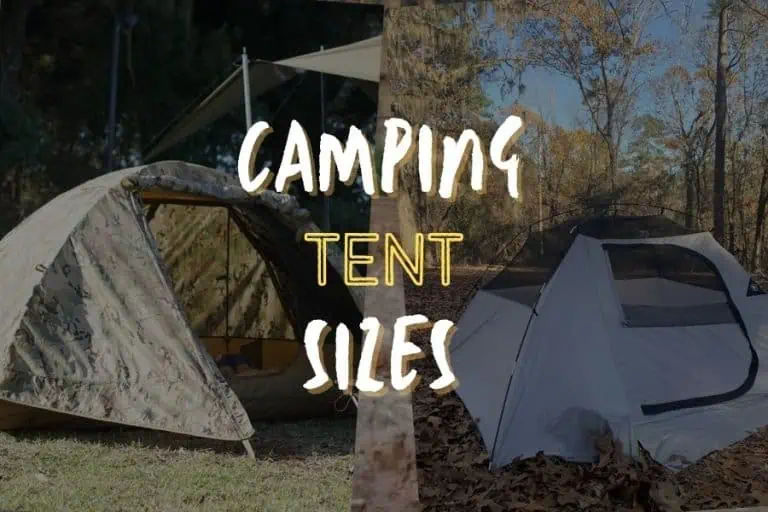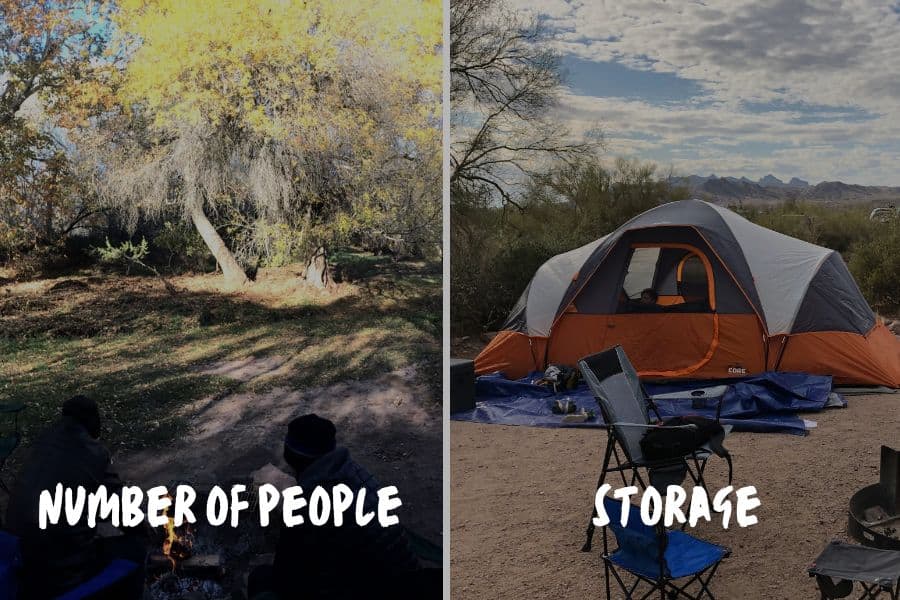Camping with family or friends can be an unforgettable experience, as long as you’re properly equipped.
And first on the list is – a tent.
Choosing the right shelter can easily make or break your trip. But that shouldn’t be an issue, as long as you know what tent size you need.
In this article, I’ll share with you all the info you’d ever want to know about tent sizes so that you can make an educated choice.
Let’s dive straight in. Here are are the tent sizes that we recommend for each size group:
| Group Size | Recommended Tent Capacity |
| 1 | 1 to 2 person |
| 2 | 3 to 4 person |
| 3 | 5 to 6 person |
| 4 | 6 to 8 person |
| 5 | 8 to 10 person |
| 6 | 10 to 12 person |
| 8 | 12 to 14 person |
| 10 | 14+ person |
| 12+ | 18+ person |
Table of Contents
ToggleWhat Size Tent Do I Need? General Observations
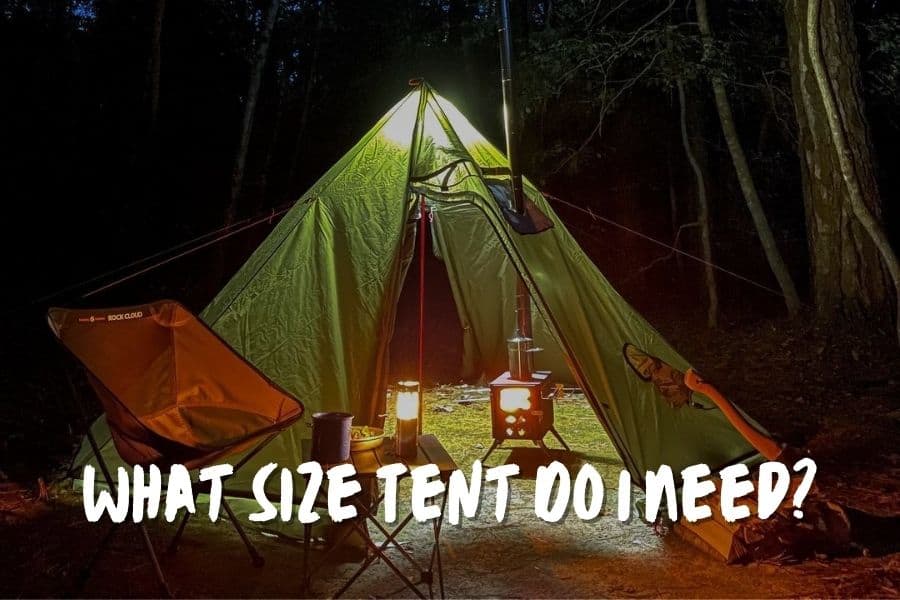
Choosing the right size for a tent is the first, and definitely most important, step.
Getting a model that’s too small can easily turn your camping trip into a horrible experience as your whole group ends up sleeping packed like sardines.
For that reason, you need to have a general idea of the tent size you need.
The sleeping tent capacity is actually based on backpacking tents.
In other words, it indicates how many self-inflating pads can be placed on the tent floor, side by side, with no space in between.
If you’re backpacking, then you actually want to stick with the tent size equating to the number of people in your group.
By cramping together, your group will remain warm inside the tent during colder days; plus, a smaller tent is easier to carry.
As for the gear, it’s outside, stored underneath the vestibule.
However, if you plan on camping in the same spot and for a longer time, then comfort is definitely something you want when it comes to tents.
That’s true whether you’re camping with your partner, friends or family.
And in that case, you need to take other factors into consideration when choosing the right tent size for your needs.
Square Footage
First things first, the square footage of a specific tent shows you exactly how big it is.
Given that tents are somewhat standardized, you can expect models with the same capacity to have similar, if not the same square footage.
That’s especially true with smaller tents. For 1 to 4-person tents, there’s no more than 5 square feet of difference between models within the same category.
As you go larger, you might find models with a more noticeable difference in the inside space.
Floor Dimensions
While square footage gives you a general idea of the space inside the tent, floor dimensions actually determine how well that space can be used.
Most tents have either a square or rectangular shape, but there are some larger models with Y, V, T and X shapes.
If you’re tall (like over 6 feet tall), you should pay close attention to floor dimensions, especially with smaller tents.
You want to find a model that’s at least 90 inches long so that there’s enough room for you to comfortably lay down.
Peak Height
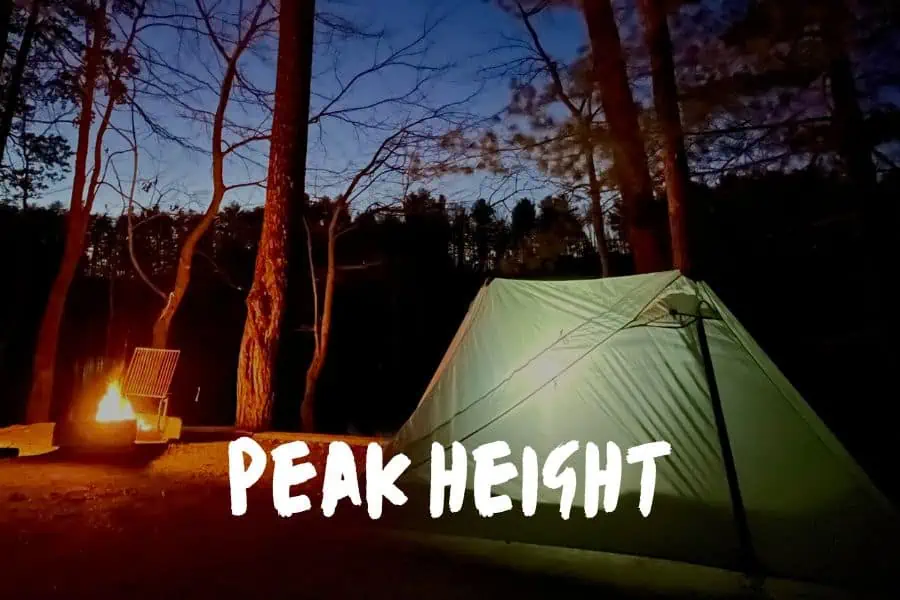
While your kid might find it amusing to crawl around the tent in order to get in or out, you probably won’t.
More likely, you’ll find it more comfortable to stand up straight and walk towards the tent doors.
Typically, the larger the tent, the taller its peak height. But that’s not always the case, as you also need to take tent shape into consideration.
As you probably know, cabin tents are usually tall enough for most people to stand up straight, while that’s not always the case with dome tents.
In fact, most 1 to 3-person dome tents are tall enough for you to sit, while most 3 to 4-person tents have a knee-high peak height.
Standing height is only found in some tents that are designed for 6 or more people.
Also See: Dome Tent VS Cabin Tent – What is the difference?
Vestibules/Awnings
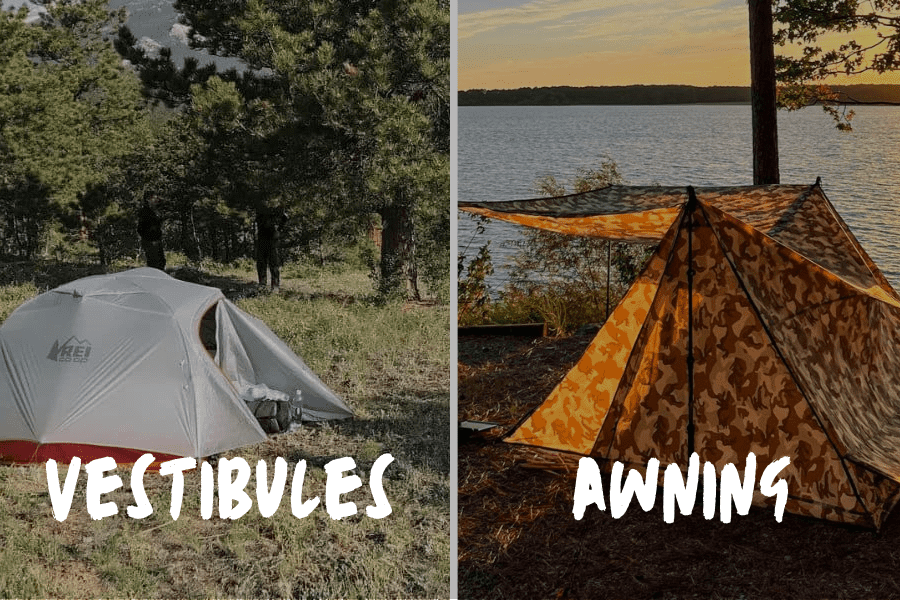
Most large tents feature at least some kind of tent extension, like a vestibule or awning.
And when choosing a suitable tent size for your camping trip, this is definitely something to keep in mind, as it provides you with additional space.
These extensions are great for storing your gear outside while keeping them safe from weather elements.
That way, you have more room inside for sleeping and simply moving around.
This is especially useful with smaller tents, even if the vestibule is big enough just for storing your muddy boots.
Large vestibules can also mimic a porch, so you can sit underneath while staying protected from wind, sun or rain.
What’s more, you can use this outdoor space to set up your kitchen when the weather doesn’t allow it any other way.
Also See: The Best Tents With Vestibules
Room Dividers
Now, a room divider is something you only see on larger tents.
But, that’s an amazing feature that can transform your setup, allowing you to make the best use of the interior space.
So for instance, you can keep your kids separated from adults for more privacy, even though they’re a few feet away from you.
Alternatively, room dividers are great for isolating the storage area.
Finally, the room divider can also serve as a movie screen for your portable video projector.
So that’s one more reason to consider getting a tent with room dividers.
Also See: Best 3 Room Tent For Large Group Camping
Tips for Choosing the Right Tent Size for Your Camping
If at this point you’re not yet sure what tent size is the right for you, I don’t blame you.
There are so many factors to take into consideration, and with so many options, making a choice is not an easy task.
To make your job somewhat simpler, here are some tips that could help you choose the right tent size.
Look at Tent Capacity
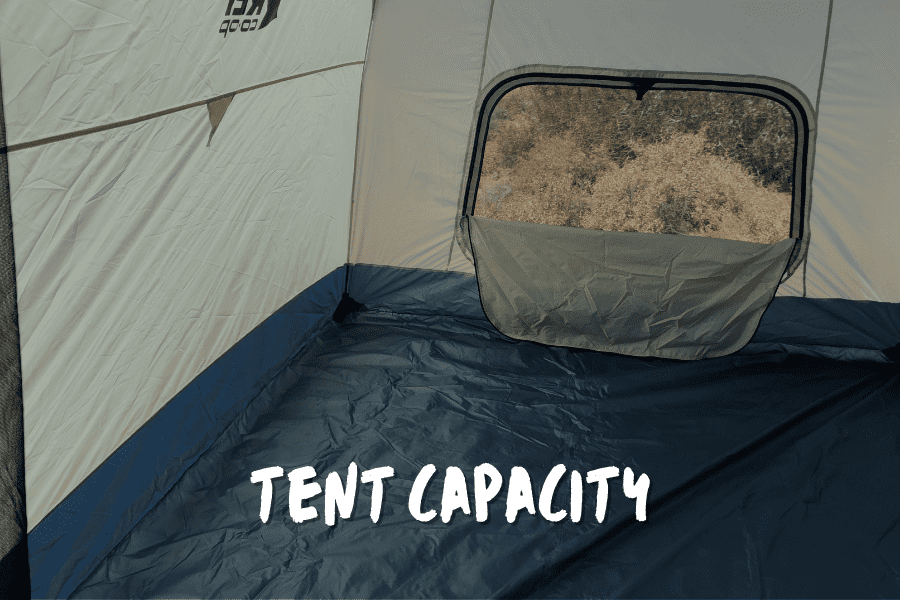
Even though the standardized tent capacity only really works if you’re backpacking, it’s still a good place to start.
After all, it gives you a general idea of how big the tent actually is inside, so you can easily compare it to your group and figure out how well it suits you.
Now, there’s something to keep in mind. Most manufacturers include the tent capacity in the product name, but that’s not always the case.
Sometimes, the product name is followed by numbers that actually indicate the length of the tent walls.
This is typically the case with models that are slightly deviating from the industry standard to accommodate taller people.
So when you’re looking at the tent capacity, looking at the product name alone isn’t enough to get the right information.
Instead, it’s always better to check out the label.
Consider Sleeping Area
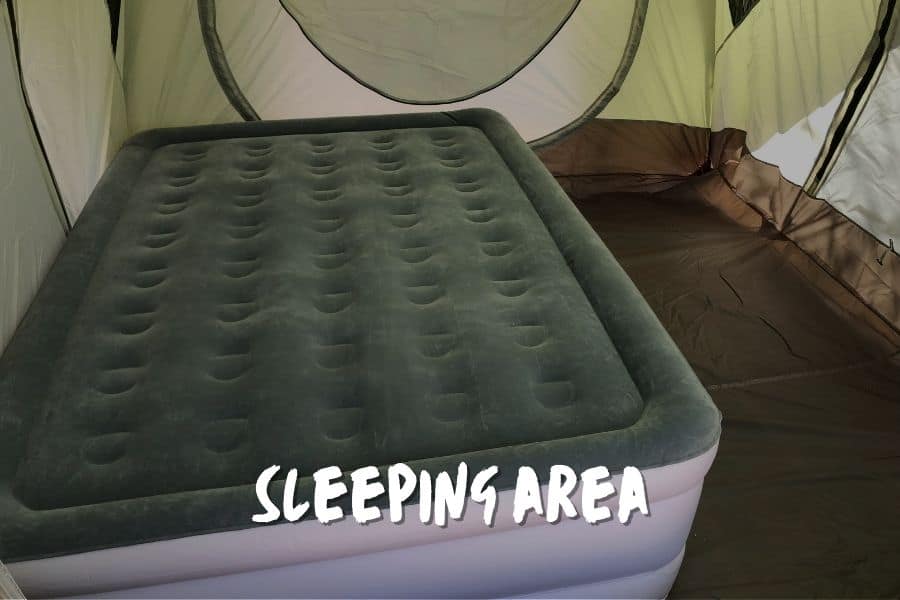
How much actual sleeping space do you need?
If you plan on hanging out inside the tent or storing your gear, this is definitely something to keep in mind.
And it’s especially important with larger tents.
Many large tents have separate rooms that are great for hanging out while staying protected from weather elements, but that also means they have a smaller section designated for sleeping.
In some cases, using the so-called “living space” for sleeping is not ideal. Depending on the model, this area might not be fully enclosed and protected from weather or insects.
Think of How Your Tent Will Be Used
If you plan on simply using a tent as a place to crash after a long day of backpacking, then you might not worry much about the size.
But if you also plan on storing your gear inside, then you need to take into consideration how much extra space you need for that.
Furthermore, will you be spending time inside aside from sleeping? Maybe the weather won’t be nice at all times, so your tent will serve as a shelter during the rain.
Or, if you’re camping with kids, you can definitely expect the tent to be used way more during the day.
Factors That Determine the Size of Tent You Need
If we take into consideration only the most important factors for deciding the size of your tent, that would be these two:
Number of People
One thing that’s clear is you can’t squeeze inside the tent more people than its tent capacity indicates. Well, not unless you want to literally sleep one on top of another.
Therefore, the number of people you’re camping with determines the smallest possible tent size you can use.
But as we already established, tent sizes indicate how many people can fit side by side, without any additional room.
So in most cases, you want to go one or more sizes up.
Storage
This is one of the main reasons why you want a tent with a higher capacity rating than the size of your group.
In most cases, everyone will have at least their own backpack and shoes, and both of those take up some space.
And the more people in your group, the more storage area you’ll need.
In case a tent features a vestibule, you’ll probably be able to store some of that gear outside, leaving you with a bit more room inside the tent.
What Are Standard Tent Sizes?
Before you choose the right size for you, here’s a quick overview of each standard tent size and its characteristics.
1-Person Tents

Smallest of their kind, 1-person tents are designed for the sole purpose of backpacking.
Why? Because they offer just enough room to fit your body – and that’s about it.
You might be able to squeeze in your backpack, but you’ll have to sacrifice a bit of space.
Alternatively, you can keep your stuff outside under the small vestibule.
Depending on the model, 1-person tents have between 15 to 20 square feet of space. They also typically have a very low profile, forcing you to crouch when moving inside the tent.
Browse the Best 1-Person Tents
2-Person Tents
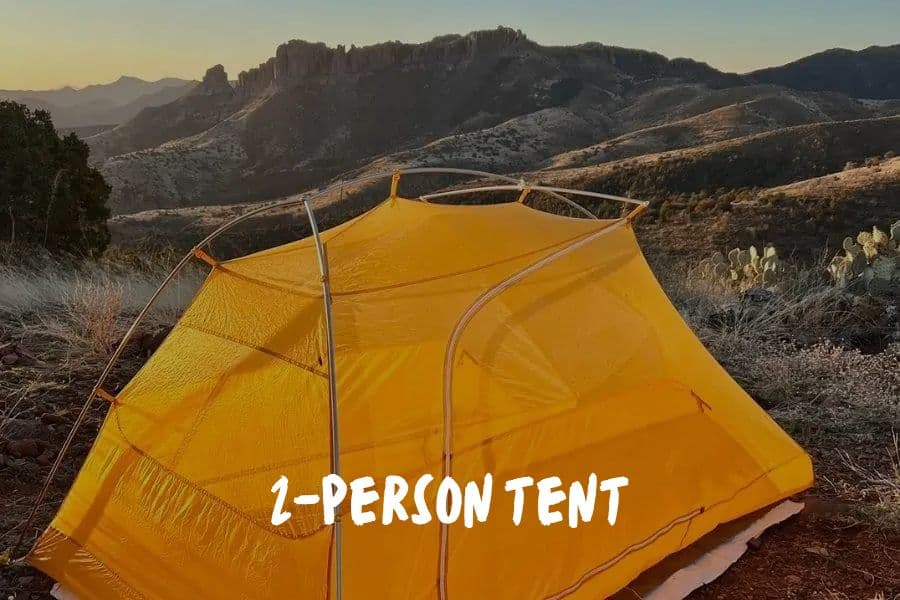
These tents are very cramped for two campers, even if they’re a couple. There’s just enough room for them to place their sleeping pads, and nothing else.
They’re suitable for backpackers, but are too small for casual campers.
However, 2-person tents are great for a solo camper with a dog, or with a lot of gear.
The average floor area of 2-person tents is between 30 and 35 square feet, and they have a low peak height, allowing you to crouch and sit, but not stand.
Browse the Best 2-Person Tents
3-Person Tents
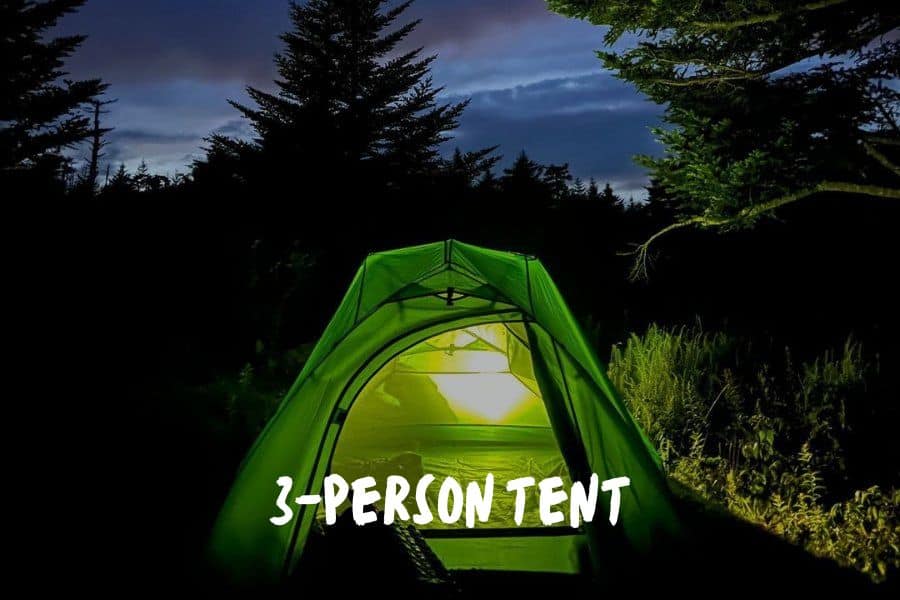
These tents are a suitable option for two people, but they’re not bad for solo campers either.
There’s about 40 to 45 square feet of space inside, so you’d have enough room for you, your stuff and even your dog.
The height difference between 2 and 3-person tents is another factor that can play a role in choosing the latter, even when you’re camping solo.
In most cases, you’ll be able to kneel, not just sit, which is the case with smaller tents.
Browse the Best 3-Person Tents
4-Person Tents
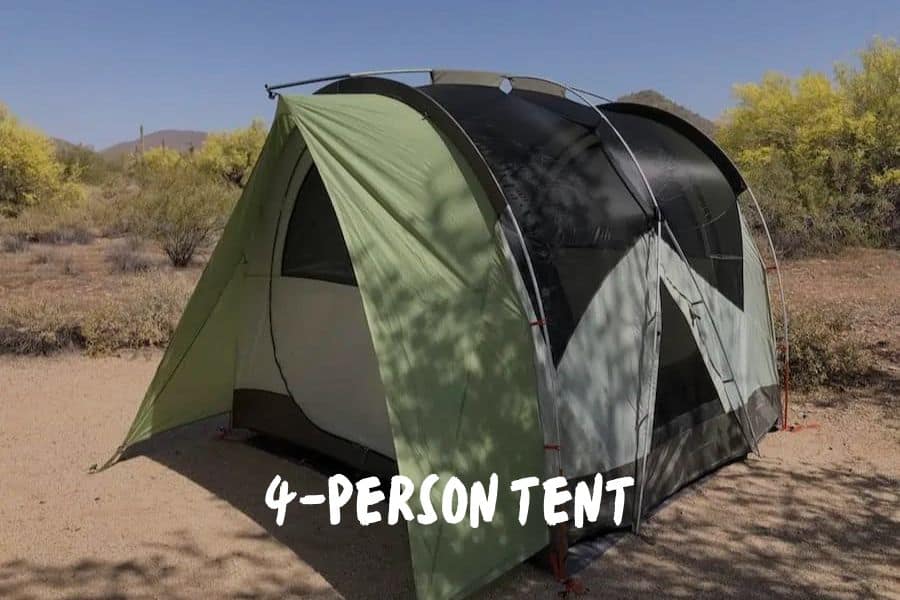
Now, 4-person tents are not suitable for a group of four, we already know that.
But, they’re considered to be the smallest family tents. And really, they’re a great option for parents with a child, for instance.
Alternatively, a 4-person tent also works well for a couple with a lot of gear. If you plan on camping for a week or two, this tent won’t be too big by no means.
Now, we hit the turning point with 4-person tents when it comes to weight.
Many models of this size tend to weigh 35 pounds or more, which is something to keep in mind if you need to walk to the campsite.
With that being said, there are also models designed for backpacking, weighing no more than 6 to 8 pounds.
Browse the Best 4-Person Tents
6-Person Tents
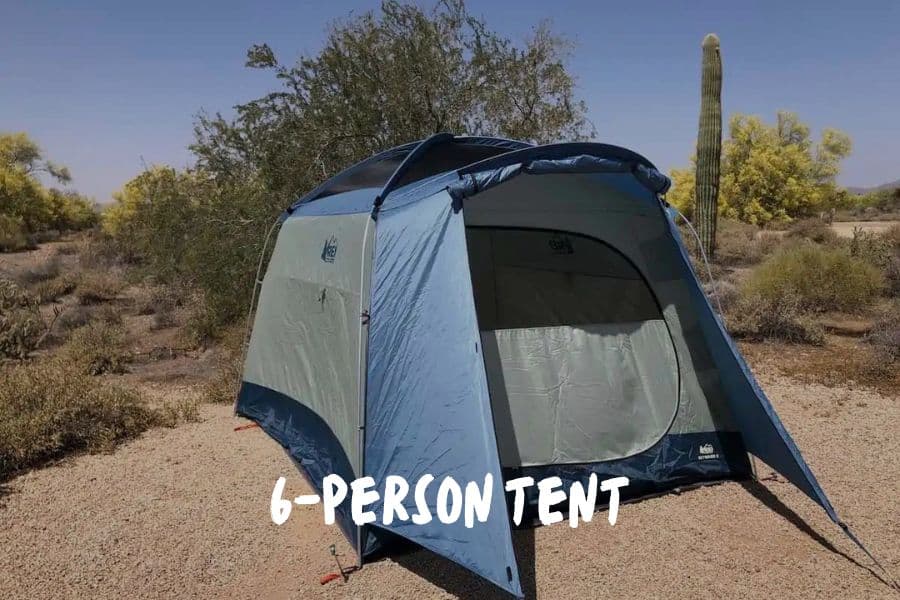
In general, 6-person tents are designed for families and large groups.
You’ll notice that most models have pretty high center points, allowing you to stand up straight for the most part.
A tent of this size is perfect for a family with two-three kids or a group of four campers.
With 90 to 100 square feet of floor area, there’s typically enough room for all of you to store your stuff inside.
At this tent capacity, you can find many models with room dividers and even separate sleeping areas, so there are quite a lot of options for you to choose from.
Browse the Best 6-Person Tents
8-Person Tents
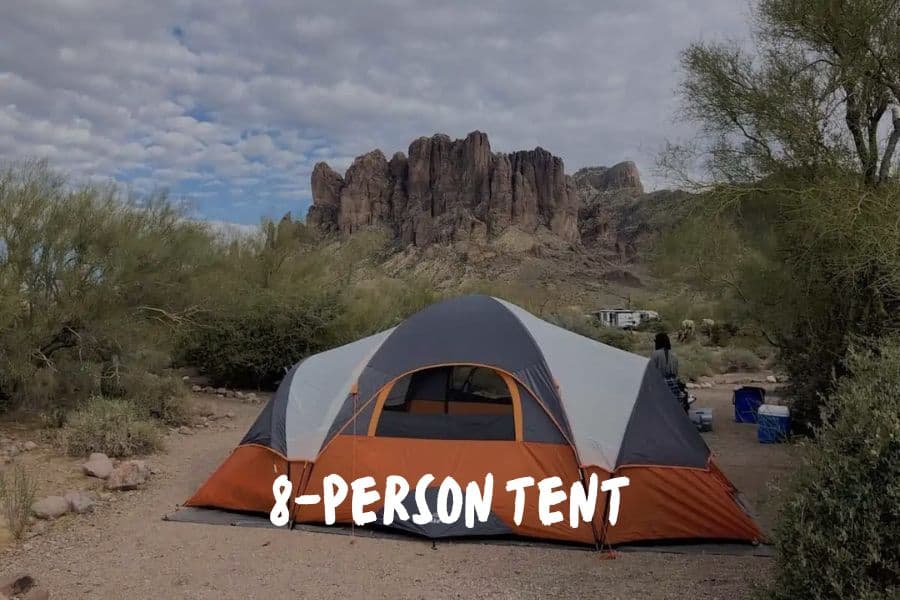
Now, this is the ideal tent size if you plan on bringing the whole family camping. Depending on the model and the shape, 8-person tents are suitable for a family of six.
Almost all 8-person tents allow you to walk inside comfortably without bending your back – unless you’re taller than Yao Ming.
They also offer quite a bit of floor area, ranging between 120 and 130 square feet.
Just keep in mind that 8-person tents come in different shapes, meaning they might offer living space, at the cost of a sleeping area.
Browse the Best 8-Person Tents
10-Person Tents
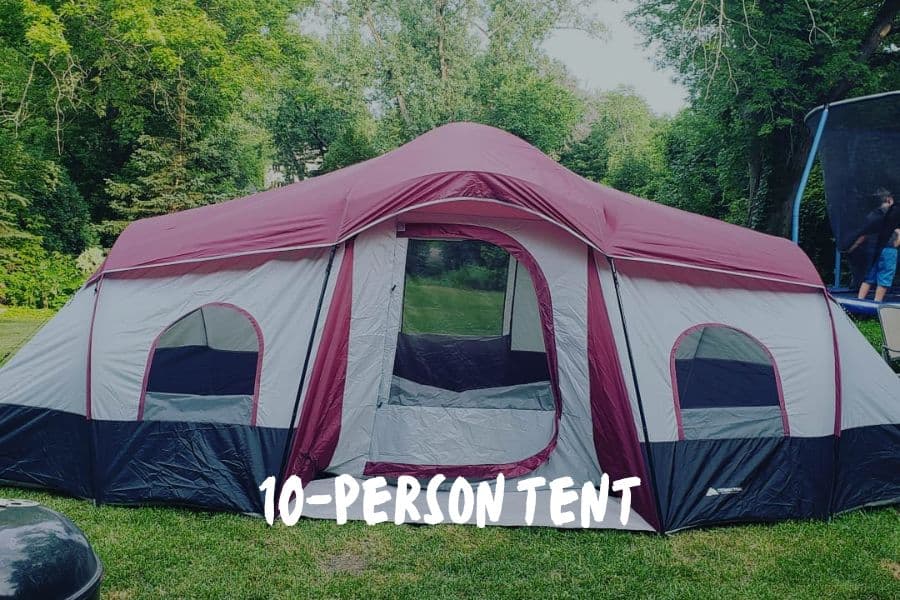
While they’re not as popular, 10-person tents can be a great investment for large families.
If your kids are young, you definitely want them sleeping in the same tent as you, and that’s where a 10-person tent comes in.
With a floor area of 150 to 180 square feet, there’s enough room for up to seven adults to sleep.
Of course, all of you will have space for storing your gear inside as well.
One thing you should keep in mind is that these tents are huge, meaning they’re more difficult to set up compared to smaller models.
And because they’re so big, they’re not typically that great for camping in bad, windy weather.
Browse the Best-10 Person Tents
12-Person Tents
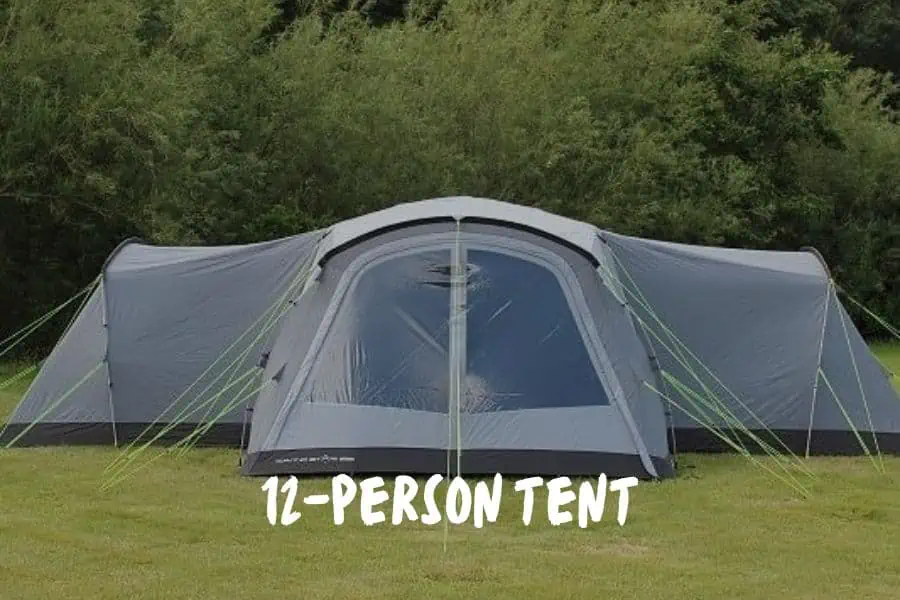
A 12-person tent is not the largest option you can find, but it’s probably the largest one you’ll see on most campgrounds.
At this point, you can see considerable differences between different 12-person models.
There’s no such thing as the standard size, as their square footage can go from under 180 square feet to as much as 300!
Just like 10-person tents, 12-person tents can be rather difficult to set up, usually requiring at least another person to give you a hand.
Browse the Best 12-Person Tents
Use Floor Space To Find The Right Size Tent
According to the industry standard, 15 square feet is the floor space capacity for one person. I’ll tell you right away – that’s way too small.
And unless you’re backpacking and pressured to remain as light as possible, forget about this standard.
So, how much space do you actually need?
I’ve decided to break that down into two categories. The first one will show you the comfortable capacity, which is suitable for most camping trips.
The other one will indicate “maximum comfort,” which leaves you enough room for sleeping, storing gear and even moving freely around the tent.
Tent Floor Space Vs. Sleeping Capacity
To be able to sleep comfortably inside the tent, you need way more than those 15 square feet.
Ideally, you want to take a tent’s rated capacity, and then reduce it by two persons.
So for instance, a comfort capacity of a 6-person tent is four people.
In that case, there’s enough room for all four of them to sleep inside the tent without bumping into each other when turning around in their sleep.
Plus, there’s also a bit of room for the gear as well.
Now, you’ll notice that this reduction is not always the same.
For instance, a 2-person tent is actually pretty comfortable for a single camper, even though it’s just one step down from the industry rating.
On the other hand, you’ll need more space when it comes to large tents for 10 or more people.
Since every camper has their own stuff, you’ll need much more room for storing gear compared to smaller groups.
So in that case, it’s best to reduce the tent rating by three, instead of two persons.
In other words, a 10-person tent is comfortable for seven, but actually cramped for eight campers.
| Rated Capacity | Floor Area | Comfort Capacity | Floor Area Per Adult |
| 1-person | 15/20 square feet | One person | 15/20 square feet |
| 2-person | 30/35 square feet | One person | 30/35 square feet |
| 3-person | 40/45 square feet | A couple | 20/22.5 square feet |
| 4-person | 60/70 square feet | A couple with a child | 30 square feet |
| 5-person | 75/80 square feet | A group of 3 campers | 25/27 square feet |
| 6-person | 90/100 square feet | A family of 4 | 20/25 square feet |
| 8-person | 120/130 square feet | A family of 6 | 17.5/20 square feet |
| 10-person | 150/180 square feet | A group of 7 campers | 21.5/26 square feet |
| 12-person | 180+ square feet | A group of 9 campers | 20+ square feet |
Tent Floor Space Vs. Sleeping Capacity For Max Comfort
Now, if you want to make sleeping as comfortable as possible, this is the rating you should use.
It takes into consideration the space you need to move freely inside the tent, as well as a spacious area for all your stuff.
To get this rating, you want to reduce the tent rating by four.
As you have probably noticed, the 1-person tent is not included in this table. That’s because a tent of that size can’t be considered comfortable in any case.
Well, it can be used for keeping your gear protected from weather elements, but it’s definitely not suitable for a comfy good night’s sleep.
| Rated Capacity | Floor Area | Max Comfort Capacity | Floor Area Per Adult |
| 2-person | 30/35 square feet | One person | 30/35 square feet |
| 3-person | 40/45 square feet | One person | 40/45 square feet |
| 4-person | 60/70 square feet | A couple | 30/35 square feet |
| 5-person | 75/80 square feet | A couple | 37.5/40 square feet |
| 6-person | 90/100 square feet | A couple with a child | 45/50 square feet |
| 8-person | 120/130 square feet | A family of 4 | 30 square feet |
| 10-person | 150/180 square feet | A group of 5 campers | 30/36 square feet |
| 12-person | 180+ square feet | A group of 6 campers | 30+ square feet |
FAQs
What is the biggest size camping tent?
Generally, 12-person tents are considered to be the biggest camping tents. However, you can find large tents ranging from 14 to 20 person capacity.
What is the smallest sized camping tent?
A 1-person tent is designed to accommodate a single adult, with nothing more than a backpack inside with them.
How big of a tent do I need for 6 people?
At the very least, you should go with an 8-person tent, which should provide you with some storage area as well as enough room for sleeping. However, a 10 or 12-person tent would offer optimal comfort.
How big of a tent do I need for 4 people?
You should go with at least a 6-person tent. But of course, you can always choose a size bigger if you’re carrying more gear with you.
How big of a tent do I need for 3 people?
For three people, a 5-person tent is an ideal option. There’s enough space for your backpacks along with your sleeping pads.
But for a bit more room, a 6-person tent will work out great as well.
How big of a tent do I need for 2 people?
A 3-person tent is a good option for a couple. However, if you’re camping with your friend and want more personal space, it’s best to go with a 4-person tent.
Do campsites charge more for bigger tents?
The typical tent camping site is approximately 12 by 30 feet in size for vehicular parking with a 20 by 20 feet camp pad to the side.
So as long as your tent fits in there, you won’t have to pay anything extra. Otherwise, you’ll need to take another camping site as well.
Final Words
With so much information in front of you, you should be able to make a decision and choose the right tent size for you.
While you can’t fit more people than the tent capacity indicates, you can definitely make everyone more comfortable by sizing up.
And with our charts, you know exactly how much area all your camping companions need.


